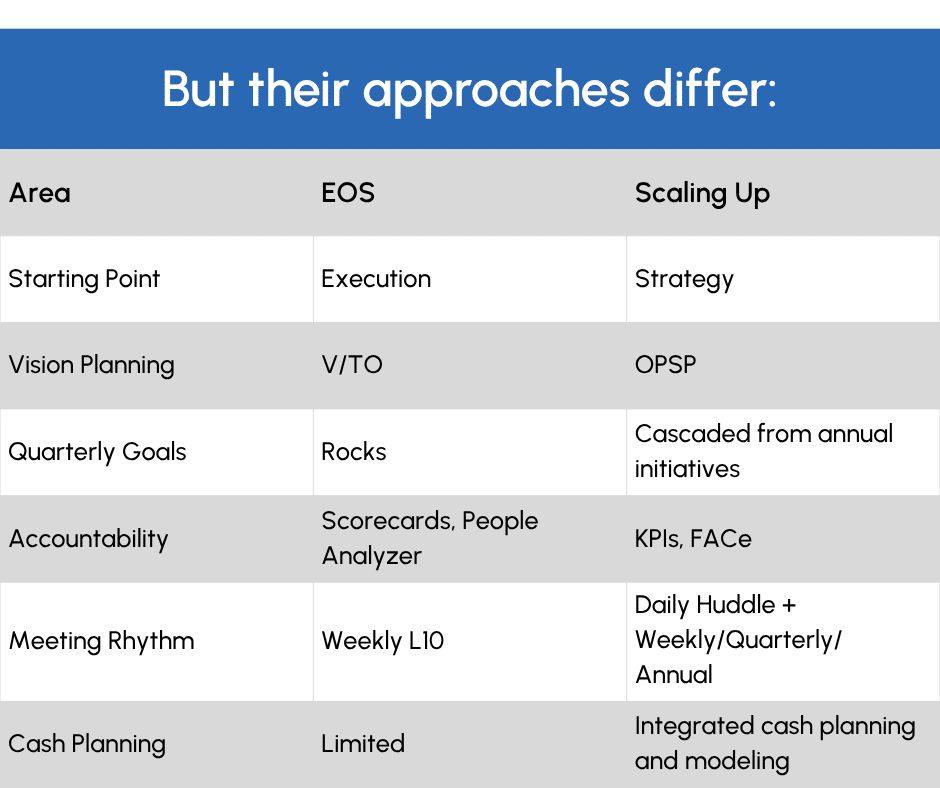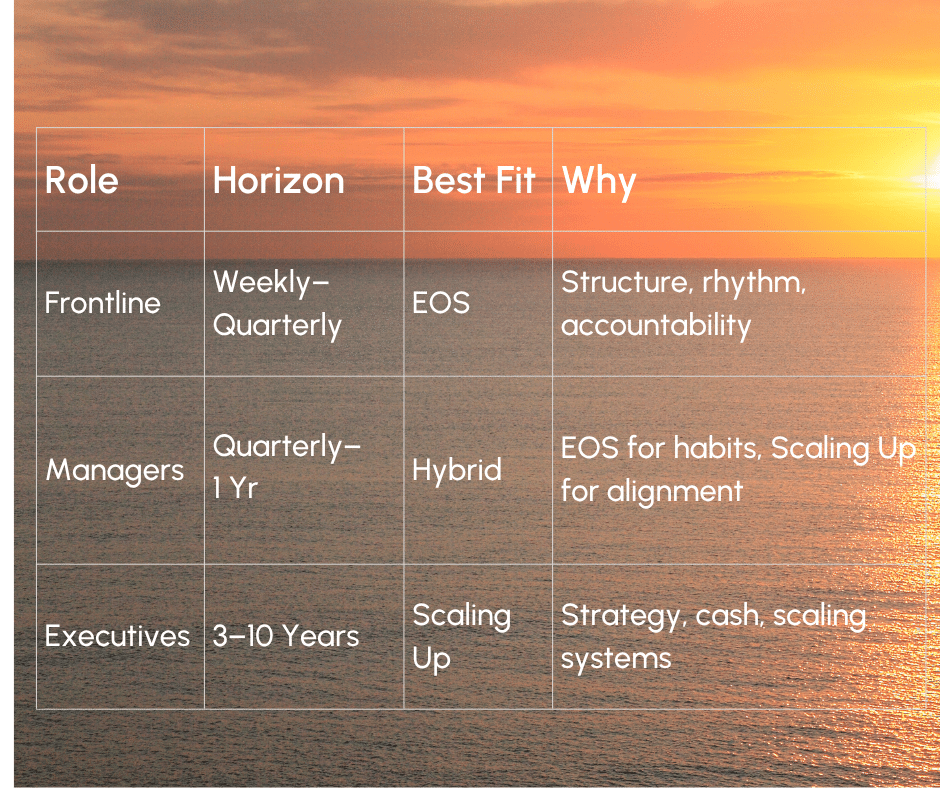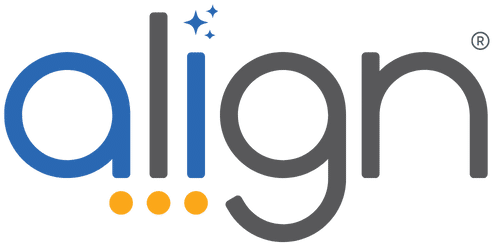If you’re leading a growing business, you’ve probably come across EOS (Entrepreneurial Operating System) and Scaling Up (from Verne Harnish). Both frameworks offer valuable guidance to improve execution, align teams, and grow more strategically. They share some commonalities, but their methods, depth, and outcomes differ in meaningful ways.
Most leadership teams think they have to choose: EOS or Scaling Up.
But what if the better option is a thoughtful combination of both?
At Align, we work with hundreds of growing businesses—some start with EOS, others with Scaling Up. The ones that scale successfully over the long term often end up using elements from each.
Why?
Because:
-
EOS brings structure and habits.
-
Scaling Up delivers strategy and scale.
Used together, they form a powerful system that supports focus, alignment, accountability, and long-term growth.
What Is EOS?
EOS (Entrepreneurial Operating System) is a simple, structured approach built for founder-led and early-stage companies. It was created by Gino Wickman and introduced in his book Traction. Wickman developed EOS after collaborating with Verne Harnish—the creator of Scaling Up—before eventually branching off to create a simplified version specifically for small, entrepreneurial companies.
-
Vision – Clear goals and strategy
-
People – Right seats on the bus
-
Data – Metrics over opinions
-
Issues – A system for resolving what’s broken
-
Process – Documented, repeatable workflows
-
Traction – Priorities, meetings, discipline
Key tools: V/TO (Vision/Traction Organizer), Rocks (90-day priorities), Level 10 Meetings, and Scorecards.
These tools help companies build consistent rhythms, focus teams, and solve problems faster. EOS is especially effective for companies in the $1M–$10M range working to move beyond chaos and into repeatable, structured execution.
What Is Scaling Up?
Scaling Up is a growth framework developed by Verne Harnish, built on his earlier work in Mastering the Rockefeller Habits. It’s designed to help mid-sized companies scale with intention. Scaling Up is particularly well-suited for companies in SaaS, professional services, manufacturing, and franchising—where systems, leadership leverage, and cash management are critical.
-
People – Alignment and accountability
-
Strategy – Market differentiation and long-term vision
-
Execution – Rhythms, priorities, KPIs
-
Cash – Cash flows that support growth
It includes tools like the One Page Strategic Plan (OPSP), Function Accountability Chart (FACe), SWT, meeting rhythms, Critical Numbers, and daily huddles.
It’s ideal for companies with $5M–$100M+ in revenue that want to grow beyond the founder and create leadership leverage, financial rigor, and scalable systems.
Core Philosophy: Tactical vs Strategic
The biggest difference between EOS and Scaling Up is the starting point.
EOS starts with execution.
It’s prescriptive, fast to implement, and ideal for companies looking for immediate structure. EOS solves today’s problems with simple tools—offering meeting structure, accountability, and clarity. It’s internal-facing and builds habits that create traction quickly.
Scaling Up starts with strategy.
It pushes leadership to zoom out: What’s our market position? What’s our BHAG? Where are we headed over 3, 5, or 10 years? Then it builds execution systems that align with strategy. While it requires more upfront thinking, Scaling Up supports complex growth, deepens team alignment, and ties performance to strategy and cash.
That said, Scaling Up does not focus on strategy alone. It provides robust tools for execution—but in a flexible format. Unlike EOS, Scaling Up does not prescribe a single way to implement its tools. Instead, it provides a flexible set of recommendations, allowing leadership to determine what works best based on the company’s stage and structure.
EOS vs Scaling Up: Where They Overlap
Both frameworks aim to create alignment, build accountability, and improve execution. They share tools like:
-
Quarterly goals (Rocks / initiatives)
-
Scorecards / KPIs
-
Meeting rhythms (Level 10s, daily huddles, quarterly planning)
-
Leadership team alignment

Why You Don’t Have to Choose
The truth is, you can use both—and we recommend you do.
-
EOS provides the execution engine.
-
Scaling Up ensures you’re executing on the right strategy.
EOS keeps teams on track week to week. Scaling Up aligns long-term goals, market differentiation, and cash needs. Together, they give your organization both discipline and direction.
How to Combine EOS and Scaling Up
The key isn’t to mash both frameworks together overnight. Instead, take a phased approach:
Phase 1: Start with EOS at the Team Level
Roll out EOS to build operational consistency and habits:
-
Set quarterly Rocks for individuals and teams
-
Run weekly Level 10 meetings
-
Track execution with a Scorecard
EOS is ideal for department-level rollouts, especially for teams needing structure, rhythm, and focus. Its prescriptive nature makes it easy to install quickly.
Phase 2: Add Scaling Up at the Leadership Level
While EOS drives execution across the company, start building Scaling Up tools with your leadership team:
-
Create your One Page Strategic Plan (OPSP)
-
Define your BHAG, long-term goals, and annual priorities
-
Build the Function Accountability Chart (FACe)
-
Identify your Critical Numbers and KPIs
-
Introduce Daily Huddles to keep the leadership team aligned
-
Establish broader quarterly and annual planning rhythms
Important: Scaling Up also includes strong execution tools (meeting rhythms, KPIs, Critical Numbers), but it leaves the implementation approach up to you. That flexibility allows you to integrate tools without overwhelming your teams.
Phase 3: Converge the Two Systems
After 2–3 quarters of running both:
-
Link Rocks to Scaling Up initiatives
-
Use the OPSP as your strategic source of truth
-
Run weekly Level 10s that include updates on Critical Numbers and long-range initiatives
-
Use daily huddles at multiple levels for real-time alignment
By now, you’ve created a hybrid system:
-
EOS creates focus, rhythm, and execution habits
-
Scaling Up adds strategy, structure, and financial alignment
Who Needs What — From Frontline to C‑Suite
Your ideal system depends on role and planning horizon:
-
Frontline Teams (Weekly–Quarterly): Need structure, consistency, and real-time problem solving. EOS excels here.
-
Managers / Directors (Quarterly–1 Year): Need operational alignment and department-level strategy. A hybrid approach fits best.
-
C‑Suite (3–10 Years): Need strategic clarity, cash discipline, and long-term planning. Scaling Up leads here.

Can You Combine the Two?
Yes—but with intention.
Some teams start with EOS and graduate to Scaling Up. Others use both simultaneously—EOS for weekly habits, Scaling Up for strategy and leadership structure.
If you’re hearing things like:
-
“We’re solving the same problems every quarter.”
-
“Our vision isn’t really differentiating.”
-
“We’re busy, but not scaling.”
You may have hit EOS’s ceiling.
If your Scaling Up rollout feels stuck due to weak execution or lack of follow-through, bring in EOS habits like Level 10s and Rocks to create traction.
What We Recommend
At Align, we’ve seen companies succeed when they:
-
Use EOS to instill habits and operational clarity
-
Use Scaling Up to shape vision, alignment, and cash strategies
-
Converge both systems over time into a single, integrated growth engine
Even small teams need strategy. Even large ones need execution habits.
With Align, you don’t have to choose. You can use EOS tools like Rocks and Scorecards alongside Scaling Up’s BHAGs and Critical Numbers—in one platform, with one system.
TL;DR
-
EOS gives you operational traction.
-
Scaling Up gives you strategic direction.
-
Combined, they give you the rhythm and vision to grow intentionally.
EOS gets you organized.
Scaling Up gets you strategic.
These frameworks aren’t opposing philosophies—they’re complementary tools. Start where you are. Build where you’re going. Make smart moves today to fuel big wins tomorrow.





